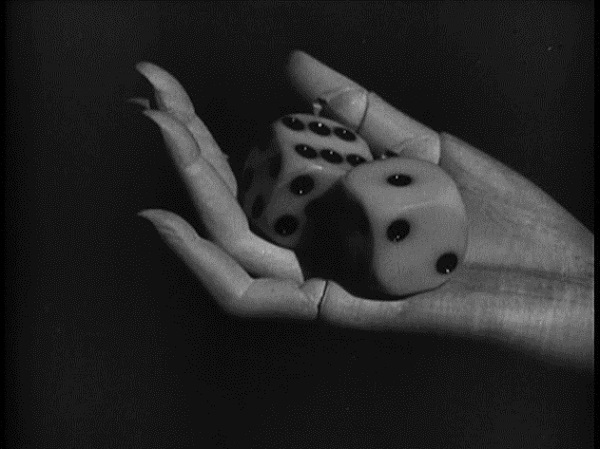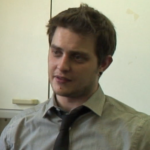On Chance – An Essay on Art
On Chance
Here I would like to discuss the creative possibilities of chance. Looking at a variety of artists and filmmakers, I shall look into different aspects of chance, how it might function and why one might look to chance. Starting with a problem with the Hollywood system of filmmaking as posed by Maya Deren immediately below, I will demonstrate that chance is an essential means of filmmaking that addresses this issue.
“…for example, one of the consequences of the assembly-line organization method of production is that the contributions of all the individuals must dovetail with each other. Even workers in the industry acknowledge the sad fact that the miles of memos and the hours of conferences which are required to achieve this can have a stultifying effect upon even the most original mind. The justifications, defences, verbalizations, and rationalizations to which a sensitive, inspired idea must be repeatedly subjected, will sooner or later destroy all the lift and spirit of it. And why should the individual who, independent of production managers, etc., has the enviable opportunity of following through his inspired promptings, willfully reconstruct such hindrances.”1
Maya Deren beautifully demonstrates a problem with the way in which films are created. This problem is very important to address as it shows how the medium of film can restrict itself from following its own progressions. Deren explains how imagination and creativity is removed from a creative art – film – when being constructed by Hollywood. If we assume that she is correct in saying that films made in such a process lack their creative and artistic power, then we must ask what is the best process to replace such a system? How would we acquire such creativity? I would like to introduce us all to chance, focusing upon some particular aspects of chance and its use and possibilities to the arts and especially – film, as a possible means to achieve such creativity.
What is chance?
Firstly to define what I mean when I say chance. Chance will refer to an event. That is that something happens by chance. This does not mean that what happens occurs without a sense of determinism. Just that it happens within a subjective framework that situates the cause as completely unknown to an individual or a group of individuals. For example, if a coin was to fall from the sky and land before an unsuspecting individual or group of individuals, I would determine this to have happened by chance. That is to say, despite the possibility that there may be a cause for such an outcome the event is to be taken independent from any possible cause. Similarly, a roll of a dice would also demonstrate this idea of chance, despite the fact that mathematically the result of the dice can be regarded as having a determinate cause.
Abstract Expressionism and Chance
Abstract Expressionism is an art movement inhabited by artists such as Jackson Pollock and Willem De Kooning, primarily during the 1940’s and 1950’s in New York.2 In many ways however, abstract expressionism could be described as putting more focus on the technique behind the art itself rather than what the art actually is. Works are realised by the artist. Jackson Pollock, for example, was described as using chaotic techniques; he “tore the top off a paint can and threw paint on the image.”3 This implies a focus on his technique and a very haphazard approach to applying the paint to his paintings. Offering another technique of painting that shows a focus on how to paint rather than what to paint and talking about the methodology behind Abstract Expressionism, Justin Wolf offers in his article ‘Abstract Expressionism’:
“interests in the unconscious, as well as its strain of primitivism and preoccupation with mythology. Many were particularly interested in the ideas of the Swiss psychiatrist Carl Jung, who believed that elements of a collective unconscious had been handed down through the ages by means of archetypal symbols – primordial images which had become recurrent motifs. (…)(this) often meant the involvement of chance in the creation of art. Pollock considered his drip technique to be at least in part a means of harnessing his unconscious; and the approach left effects to chance for all to see on the surface of the canvas.”4
Here a useful suggestion concerning the raison d’etre of such individual minds allows for a possible understanding of why such practices were used. It is suggested that in a search for the primitive symbols of the unconscious these artists allowed for chance to intervene in the creative process. Either way it is clear that such artists gave precedence to how they painted over what they painted. This is important since it suggests that many of the techniques they used served to look at how they painted rather than what they painted. In so doing they often looked to remove part of the artist’s conscious control over what they painted. This is achieved by methods such as dripping and throwing paint at a canvas among others, which allow chance to help direct the final outcome.
Surrealism and Chance
Surrealism, an earlier movement formed in 1924, also emphasised the benefits of chance. Surrealism stressed an interest in the pure representations of the unconscious, which was believed to be completely without rational influence.5 The Surrealists’ stance was to use techniques that act by “removing some of the restraints exerting a retarding influence”6, so that logic could be overthrown and imagination could be released from its stranglehold. The founder of Surrealism, André Breton, also speaks of the art of Surrealism: “It is true of Surrealist images as it is of opium images that man does not evoke them; rather they “come to him spontaneously, despotically. He cannot chase them away; for the will is powerless now and no longer controls the faculties.”7 Surrealism strongly believed that rational logic was a hindrance to the imagination and in order to free such sublime images one had to evoke the unconsciousness through dreams and automatism primarily. André Breton in the ‘first Surrealist manifesto‘ offered this definition of Surrealism:
“SURREALISM, n. Psychic automatism in its pure state, by which one proposes to express – verbally, by means of the written word, or in any other manner – the actual functioning of thought. Dictated by thought, in the absence of any control exercised by reason, exempt from any aesthetic, or moral concern.
ENCYCLOPEDIA. Philosophy. Surrealism is based on the belief in the superior reality of certain forms of previously neglected associations, in the omnipotence of dream, in the disinterested play of thought. It tends to ruin once and for all other psychic mechanisms and to substitute itself for them in solving all the principal problems of life.”8
Surrealism’s emphasised techniques such as automatism, expressed ideas and images through expressing them without thinking about them at all. “(T)he decision reached by the surrealist when electing to avail himself of the automatic method (or the step he took when writing automatically without prior discussion or reflection) responded to the challenge why write? subsumed in an answer to the question How to write?”9 Such techniques, the surrealists believed, were important for the true function of Surrealism. Chance allowed for a process devoid of these ‘retarding influences’ and served as a function of the art movement. Here chance opens up the unconsciousness in its purest form.
Dada and Chance
Dada could be described as an anti-art movement, that before Surrealism also made extensive use of chance. Despite the similarities, however, Dada used chance as an affront to a society that had misplaced its values, rather than to evoke the true representation of unrestrained thought (a slight, but important, difference). Dada sought chance in order to destroy the commercialism that had enraptured art, by producing ready-mades or collages that largely used found objects. These were then reorganised or a different viewpoint was asked of them.10 When someone creates a work of Dada: “What results is a work of art that is non intentional (…) where the artist exiles himself from the work he produces.”11 Here it is suggested that chance, through Dada, acts as a destructive method aimed at commercialism. An example of such a work was Marcel Duchamp’s Unhappy Readymade 1919.12 He not only used objects that were pre-constructed using what he found, but he also allowed other external influences to shape his work.
“This object was constructed from a text book – a treatise on geometry – opened face up, hanging in mid-air and rigged diagonally to the corners of a porch. It was left suspended there for a period of time, during which the wind could blow and tear its pages of geometric formulae, the rain drench them, and the sun bleach and fade them.”13
Chance is used as a means of letting wind, rain and the sun become agents of the creative process. Marcel Duchamp could not have known the repercussions of such an act, but in-so-doing he embraced a system that served as a creative construction of this work – and in true Dada spirit too!
Chance in the filmmaking process part 1: Art Cinema
What would these interpretations of Chance mean for film? How could this be applied to the creative process of filmmaking? Going back to Surrealism for a moment and focusing on Un Chien Andalou (d. Luis Bunuel, Salvador Dalí France 1929) I would like to demonstrate how an immensely powerful film was created with the help of chance.
“We wrote with minds open to the first ideas that came into them and at the same time systematically rejecting everything that arose from our culture and education. They had to be images that would surprise us and that we would both accept without discussion. Nothing else. For example: The woman seizes a racket to defend herself from the man who is about to attack her. And then he looks for something to counterattack with and (now I’m speaking to Dalí) ‘What does he see?’’A flying toad.’ ‘No good.’ ‘A bottle of brandy.’ ‘No good.’ ‘Well, he sees two ropes.’ ‘Good, but what’s on the end of the ropes?’ ‘The chap pulls on them and falls because he’s dragging something very heavy.’ ‘Well, it’s good he falls down.’ ‘Attached to them are two dried gourds.’ ‘What else?’ ‘Two Marist Brothers.’ ‘That’s it! Two Marists. And then?’ ‘A Cannon.’ ‘No good.’ Let’s have a luxury armchair.’ ‘No, a grand piano.’ ‘Very good, and on top of the grand piano a donkey, no two donkeys. ‘Wonderful.’ Well, maybe we just drew our irrational representations with no explication…”14
Luis Bunuel speaks about an application of the ideas of automatism, as seen by Surrealism, upon the construction of the film: Un Chien Andalou. The conceptual writing process is approached with an automatic mind-set, snatching ideas from the depths of the sub-conscious; no idea is overly criticised by an assembly-line organisation. Each idea was discovered automatically. This automatism embraced a spontaneous confidence in ideas that would be discovered without any known cause. Spontaneous embrace of a chance occurrence – it could be said. This could create a most imaginative film, one that represented true Surrealist conceptions of their idea of chance. To them, Chance allows for a free imagination. This is one method in which chance allows ideas, concepts and writers to combine their efforts in a film’s creation.
Another filmmaker, David Lynch, could be described as embracing aspects of chance for his films. “‘I remember holding the film up to the light to see frames, and I saw no frames. (…)If that had come out and I had sent that to the American Film Institute, it wouldn’t have been good enough to get me the grant I got later. And of course, that grant I had to have, if I was going to get into film. So fate was smiling on me.’”15 Instead of viewing it as a problem Lynch saw it as a blessing. This might seem like mindless optimism but there is an awareness of fate and an outside force acting upon his creative process that was largely beneficial to the film’s construction. Similar to Un Chien Andalou’s creative process, David Lynch has also commented that “things would reveal themselves to us as we were going along.”16 This is important to consider as it also evokes the ideas of the Abstract Expressionists who saw the work as revealing itself to the artist through the artist’s own actions, as previously discussed. Lynch suggests that he allows himself to be taken by ideas that come to him seemingly independently of any restraints, logical or otherwise. He also shows an opportunistic instinct in his attitude to problems, found objects, sets and situations. “fate also played a part. First, Lynch found that in the grounds of the Center were several vacant outbuildings, including what would once have been stables, garages, greenhouses, servants’ quarters and a huge hayloft.”17 This describes the construction process of the set for Eraserhead.
Man Ray also made use of chance most extensively for many of his cinematic works, commenting that: “All the films I made were just so many improvisations”.18 Similar to Un Chien Andalou and David Lynch’s ethos, Man Ray had a respect for the creative possibilities of spontaneous creation, evoking the immediate imagination. This was certainly true of Le Retour a La Raison (d. Man Ray France 1923) a Dada film whose impact is made more significant by fate and chance. “I promised to have something for the next day.”19 So Man Ray in very little time conceived of an idea before it could be over-thought, improvising concept and direction but he went further. “On some strips[of film] I sprinkled salt and pepper, like a cook preparing a roast, on other strips I threw pins and thumbtacks at random;”20 This showed a complete disregard for any preconceived ideas of mise-en-scene, as all objects and furthermore cinematography was thrown askew by his haphazard regard for what was going on. However in true Dadaistic style fate allowed for the premier of Le Retour a La Raison to be a Dada event: “suddenly the film broke, due to my inexpert mounting. The theater remained dark while the film was being repaired.”21Chance conceived of something greater than the initial film and acted by destroying any commercial ideas of what cinema-going entails.
Chance and the filmmaking process part two: Mainstream Cinema
Despite their opposition to mainstream cinema, the Surrealists conceived of a lot of practical applications as I hope to prove. Marcel Mariën offers in ‘Another kind of Cinema’ that:
“It is worthwhile to remember that the cinematographic language is an accretion of editing practices, and that its most elementary aspects, such as the close-up, were the product of mechanical accidents, technical mishaps, that were almost always in opposition to the film-maker’s intentions. From Archimedes’ bath to the discovery of penicillin by way of universal gravitation, accident has been a characteristic of human invention. Accident operates in almost all important discoveries.”22
He reminds us that cinema and inventions, do in fact come by chance. One accident that is found to have pleasing results is then copied and becomes the norm. Why would we necessitate a logical order when chance has so much to do with what we know? He goes on: “We recall that the cinema owes its crucial resources to chance; furthermore, that it owes its present distress in large part to radical changes in working methods that came with the invention of “talking” films.”23 Such is the connection I make between chance and the problem demonstrated by Maya Deren.
So how can film use chance? I will explore this by discussing the use of chance in different scales.
“In the final analysis, regardless of the disappointment it gave some people to learn that Luis Bunuel arrived accidently at the visual parallel we are shown in Viridiana between the disciples gathered in da vinci’s last supper and the beggars assembled at the dining table the important thing is that Bunuel took care to acknowledge publicly that chance had intervened beneficially in his movie.”24
Chance intertextuality can be very beneficial, but in a film where almost everything is planned, chance can still prevail. To improve one’s chances, one may offer an improvisation on the part of an actor whose character is fully discussed beforehand. In this instance, we focus upon the filmmaker as the creative mind and therefore the actor represents a subjective meaning that may not be seen by the filmmaker. To go a step further, actors and crew can completely submit themselves to chance as they allow their craft to happen instinctually from within. Chance can be used as a conceptual tool on a larger scale. Writers may compose their scenarios basing important decisions on the role of the dice, a flip of a coin or simply by following an idea without any idea of where it may take them. Adopting a larger perpesctive, chance may allow for the entirety of a film’s narrative(s), characters, editing, cinematography, mise-en-scéne to be created without any control, submitting oneself completely to chance. For example, abstract patterns may accidentally create figures and may show a disregard for the cinema frame and any connections may be realised independently of other narrative elements. This method appears in Le Retour a la Raison.
To conclude
Throughout these methods Chance consistently encourages the embracing of spontaneity. Something happens and rather than questioning it you trust in it – you ‘take a chance’ on something. I will stress however, that just because one subjects oneself to chance, it does not mean one operates without any knowledge of what one is doing, or completely in chaos. The Abstract Expressionists would stress their control over their works despite their respect of chance.25 For example, a flick of the brush is a controlled action, despite allowing chance to dictate the end pattern and consistency of the paint on the canvas. In this way many of the aforementioned examples of embracing chance would operate with preconceived ideas about how it could operate. These preconceived ideas would plan what it could mean on the rest of the film and the amount it could operate on the film. For example, a flip of a coin could dictate a decision between two ideas by a character – like to go somewhere or not. This would significantly change neither the character nor the style of the film. This would also only follow one of two already planned ideas – such as to go or not to go. However it still allows for chance to aid in the creative process. The Surrealists suggest, that this would allow the imagination to be brought forth from the sub-conscious. The Abstract Expressionists would suggest, it stresses how the outcome is realised by the artist. The Dadaist’s would suggest that this would act as an end to order and take cinema to the roots of creation. In this way, allowing for such things to be embraced would be an answer to Maya Deren’s problem.
1Deren, Maya (A), McPherson, Bruce (Ed). Essential Deren: Collected Writings on Film, McPherson & Co Publishers, US, 2005: pp 156.
2 Stangos, Nikos. ‘Abstract Expressionism’ in: Concepts of Modern Art: From Fauvism to Postmodernism. Thames and Hudson ltd, 1994: pp 169-211.
4Wolf, Justin. ‘Abstract Expressionism’ on theartstory.org, at www.theartstory.org/movement-abstract-expressionism.htm (30.11.12 accessed)
5Breton, André. ‘First Manifesto of Surrealism’ in Manifestoes of Surrealism, Breton, André (A); Lane, H.R. (Trans); Seaver, R. (Trans). The University of Michigan Press, 1969: pp3-47.
7Breton, André. ‘First Manifesto of Surrealism’ in Manifestoes of Surrealism, Breton, André (A); Lane, H.R. (Trans); Seaver, R. (Trans). The University of Michigan Press, 1969: pp36.
8Breton, André. ‘First Manifesto of Surrealism’ in Manifestoes of Surrealism, Breton, André (A); Lane, H.R. (Trans); Seaver, R. (Trans). The University of Michigan Press, 1969: pp26.
10 Stangos, Nikos. ‘Dada and Surrealism’ in: Concepts of Modern Art: From Fauvism to Postmodernism. Thames and Hudson ltd, 1994: pp110-137.
11Dickerman, Leah; Witkovsky, Mathew S.. The Dada Seminars: CASVA Seminar Papers 1: CASVA Seminar Papers v. 1, Distributed Art Publishers, 2005: pp 210.
13Dickerman, Leah; Witkovsky, Mathew S.. The Dada Seminars: CASVA Seminar Papers 1: CASVA Seminar Papers v. 1, Distributed Art Publishers, 2005: pp 211.
14 Louis Bunuel cited in Wes D. Gehring, The Max Brothers: A Bio-Bibliography, Greenwood Press, New York, 1987, p.173. Cited in Taylor, “Hallucinatory Celluloid’, op.cit. taken from Dalí, Surrealism and Cinema.
15David Lynch cited in Hughes, David. The Complete Lynch. Virgin Books ltd, 2001 (2002 reprinted): pp 9.
16David Lynch cited in Hughes, David. The Complete Lynch. Virgin Books ltd, 2001 (2002 reprinted): pp20.
18Ray, Man cited in: Knowles, Kim. A Cinematic Artist The Films of Man Ray. Peter Lang Ltd, 2012: pp6.
19Ray, Man. ‘Dada Films and Surrealism’ in: Self Portrait. Penguin Classics, 1963 (2012 Penguin Classics Edition): pp 260, pp259-288.
20Ray, Man. ‘Dada Films and Surrealism’ in: Self Portrait. Penguin Classics, 1963(2012 Penguin Classics Edition): pp 260, pp259-288.
21Ray, Man. ‘Dada Films and Surrealism’ in: Self Portrait. Penguin Classics, 1963 (2012 Penguin Classics Edition): pp262.
22Marien, Marcel. ‘Another kind of Cinema’ in: Hammond, Paul (Ed). The Shadow and its Shadow: Surrealist Writings on the Cinema. City Lights Books, 2000 (3rd Edition): pp139, pp135-146.
23Marien, Marcel. ‘Another kind of Cinema’ in: Hammond, Paul (Ed). The Shadow and its Shadow: Surrealist Writings on the Cinema. City Lights Books, 2000 (3rd Edition): pp141, pp135-146
25Wolf, Justin. ‘Abstract Expressionism’ on theartstory.org, at www.theartstory.org/movement-abstract-expressionism.htm (30.11.12 accessed)
Bibliography
Duchamp, Marcel, Unhappy Readymade, 1919
Furstenau, Marc. Film Theory Reader: Debates and Arguments. Routledge, 2010.
Gibson, Ann Eden. Abstract Expressionism: Other Politics. Yale University Press, 2000.
Hughes, David. The Complete Lynch. Virgin Books ltd, 2001 (2002 reprinted).
King, Elliot. Dali, Surrealism and Cinema. Kamera Books, 2007.
Knowles, Kim. A Cinematic Artist The Films of Man Ray. Peter Lang Ltd, 2012.
Lynch, David (A). Rodley, Chris (Ed). Lynch on Lynch. Faber and Faber Press, 2005 (Revised Edition).
Matthews, J. H.. Surrealist Mind. Susquehanna University Press, 1991.
Nikolaevich, Kinkov Valeriy. ‘American Abstract Expressionism Painting Style’ on kikov.com, at http://www.klinkov.com/abstract-expressionism-artwork (30.11.12 accessed)
Wolf, Justin. ‘Abstract Expressionism’ on theartstory.org, at www.theartstory.org/movement-abstract-expressionism.htm (30.11.12 accessed)
Further Links of Interest
http://www.tate.org.uk/art/artists/marcel-marien-8402
http://www.ubu.com/film/ray.html
http://www.jacksonpollock.org/
http://arthistory.about.com/cs/arthistory10one/a/dada.htm
Maya Deren on Senses of Cinema








Leave a Reply